TransitSearch Candidate Light Curves
Links internal to this web page
Introduction
GJ 876d
HD 68988
HD 80606
HD 17156
HD 64468
HD 46375
GJ 176
Introduction
Most of the known exoplanets were discovered
from periodic variations in the host star's velocity. Only a
small fraction of these will have the orbit inclinations that produce
transits for Earth observers. For Jupiter-size exoplanets with close-in
orbits the chance for transits could be 2 to 10% that the planet will
transit in front of the star, causing fades of 1 - 3 % (10 to 30 mmag)
and lasting 2 or 3 hours. Very few of the 250 or so stars known to have
exoplanets have been observed sufficiently to know if transits are also
occurring. However, the radial velocity data are usually adequate for predicting
when a transit would occur if the inclination is sufficiently close to
90 degrees. The TransitSearch
web site lists these times for a large number of candidates
as a service to observers interested in ruling-in or ruling-out
the presence of transits. Most attempts to find a transit for candidate
stars in the TransitSearch list are destined to be featureless, but
consider that the payoffs are big for actually determining that transits
exist. Consider the case of GJ 436! It languished on the TransitSearch
list for a couple years before an amateur/professional group discovered
that transits were occurring at the times listed on the TransitSearch
web site.
When I was a member of the XO Project Extended
Team of amateur observers it was common to observe candidates
that turned out to be "blended eclipsing binaries" that mimicked
exoplanet transits in the wide field survey camera images. In
fact, there were so many "EB blends" that it became customary to
assume that each new candidate on the XO list was going to be another
EB. My reason for explaining this is to convince you that your chances
of discovering a new exoplanet using the TransitSearch list are comparable
to your chances of co-discovering an exoplanet by observing as a
member of a group of amateurs who are privy to a secret list of wide
field survey camera candidates.
In the next section of this web page I'll place
light curve plots for observations submitted to the AXA. Most
of them, of course, will be featureless, because only a small
percentage of the TransitSearch candidates will exhibit transits
at the predicted times to look for them. Please understand that featureless
LCs are useful; they can be used by the professional astronomers to
rule-out orbital inclinations near 90 degrees, which is an additional (small)
constraint for modeling the planetary system.
Light Curves for Various Exoplanets in
the TransitSearch List
GJ 876d
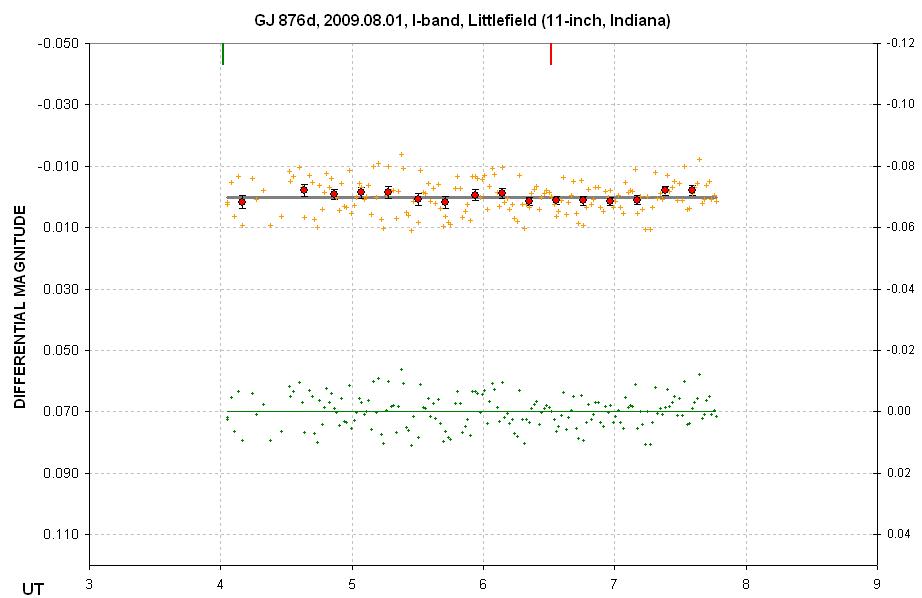

9801LC2
HD 68988
Material for this exoplanet system has been moved to
the following link: hd68988. I declared
the possibility for transits of this exoplanet system "dead" on March 29,
2009.
HD
80606
Winn et al (2009) coordinated observations for the 2009 June 4/5
transit event and was very successful in combining data to produce the following
LC:
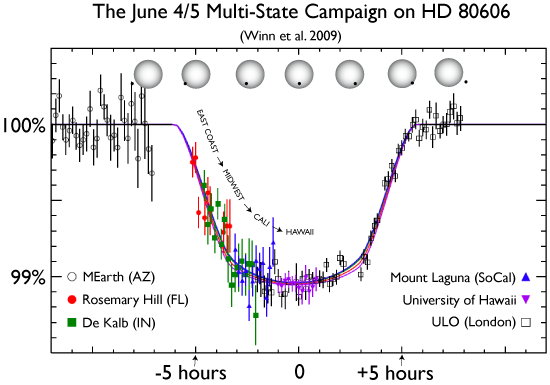
Taken from Winn et al: http://fr.arxiv.org/abs/0907.5205
More later...
------------------------------
Greg Laughlin alerted the astronomy community
about an opportunity to observe a possible primary transit of HD
80606b on Feb 13/14, 2009. The prediction is based on his observation
of a secondary transit with the Spitzer space telescope (using an infrared
band) in late 2008. HD 80606 is at RA/DE = 09:22:37.6 +50:36:13 and
V-mag ~8.5 ("bright"). Here's a useful depiction of possible
transit conditions.
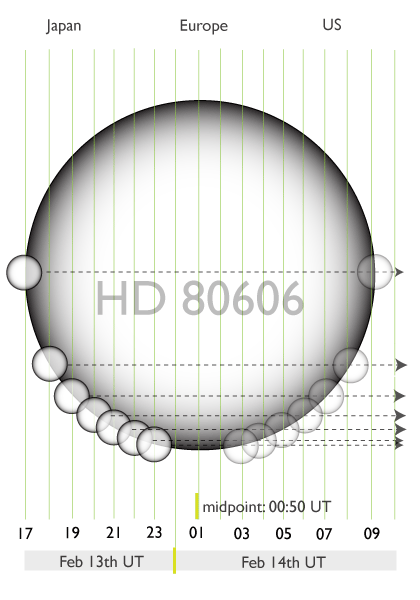
Predicted timing for primary transit of
2009.02.13/14 (courtesy Greg Laughlin).
The light curves for this event that follow failed to show the
transit, some because ingress and egress did not occur during the observing
session, and in one case because of severe noise produced by clouds.
I include it here for "completeness," in case some other question arises
that may require nearby OOT data.
Egress was observed by three groups at ~1.5 UT on 2009.02.14.
Preliminary manuscripts can be found at the following sites:
Moutou et al http://arxiv.org/abs/0902.4457
Fossey et al http://exoplanet.eu/papers/fossey.pdf
Garcia & McCullough
http://arXiv.org/abs/0902.4493
11 Srdoc Pre-Ingress LC
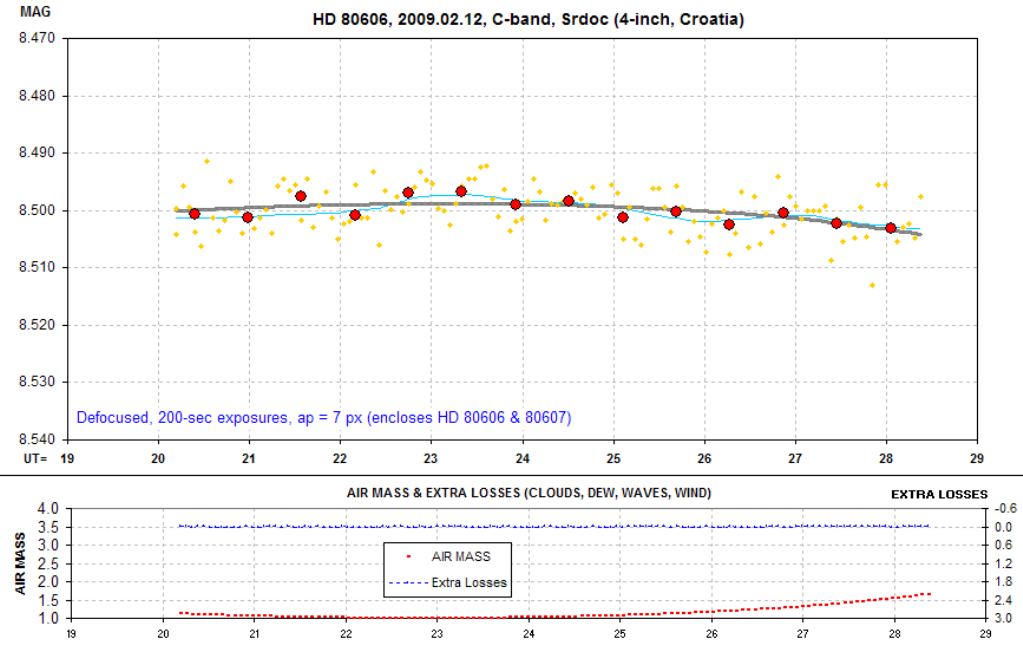
These observations ended ~9.8 hours before ingress
(adopting the Garcia & McCullough model).
10 Stael's
HD 80606 for 2009.02.14
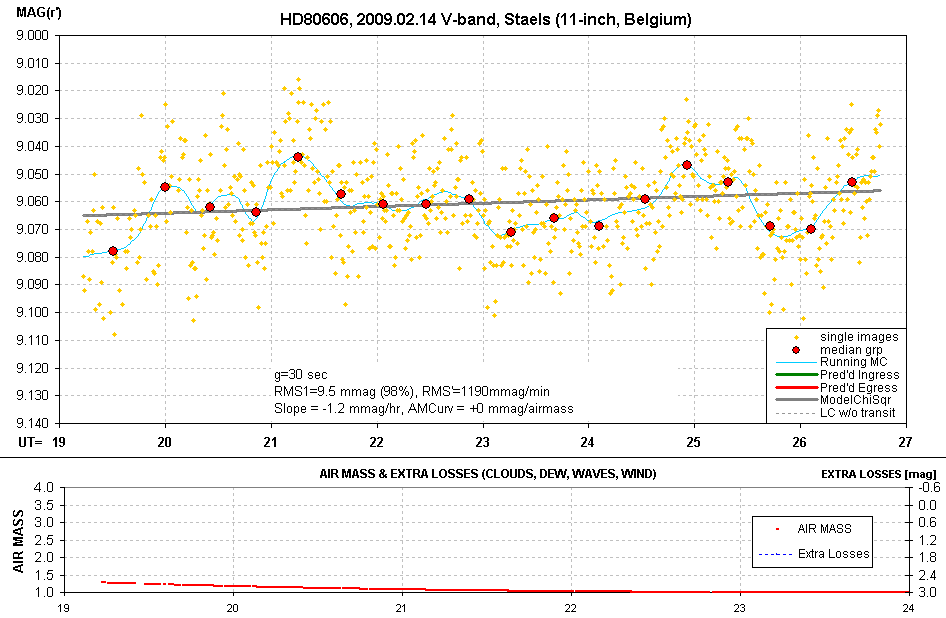
9 Stael's HD 80606
for 2009.02.13

9213SBL1
Weather was a factor, which eventually forced an observing shut-down.
8 Srdoc's HD 80606 for
2009.02.13/14
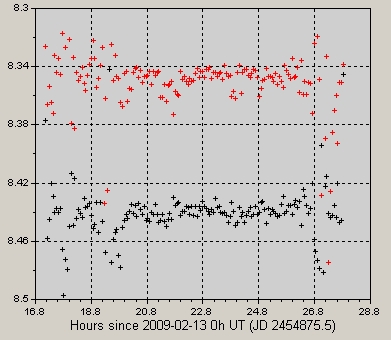
Gregor Srdoc's initial reduction shows
no event between ~20.7 UT Feb 13 and ~ 26.7 UT Feb 14.
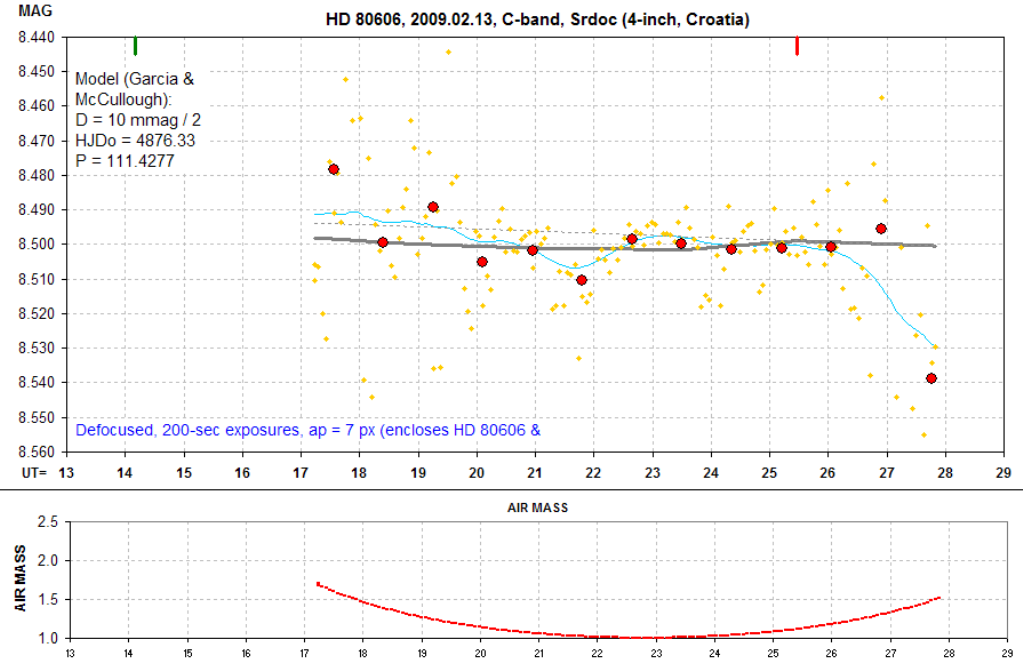
Egress was observed by at least 3 European observers to have
occurred at ~01.5 UT, Feb 14 (or 25.5 UT on this plot of Feb 13 UT hours).
The depth was measured by them to be ~10 mmag for the star HD 80606. The
light curve plotted here is from defocused images requiring a photometry
aperture that included both stars. The expected depth for such a LC is
therefore ~5 mmag. Because the clouds produced large variations of extra
losses (seen in following graph) the data are too noisy to discern the
egress feature.

This is a plot of "extra losses" due to clouds for Srdoc's observing
(LC plotted above).
7 Gary's HD 80606 for
2009.02.14
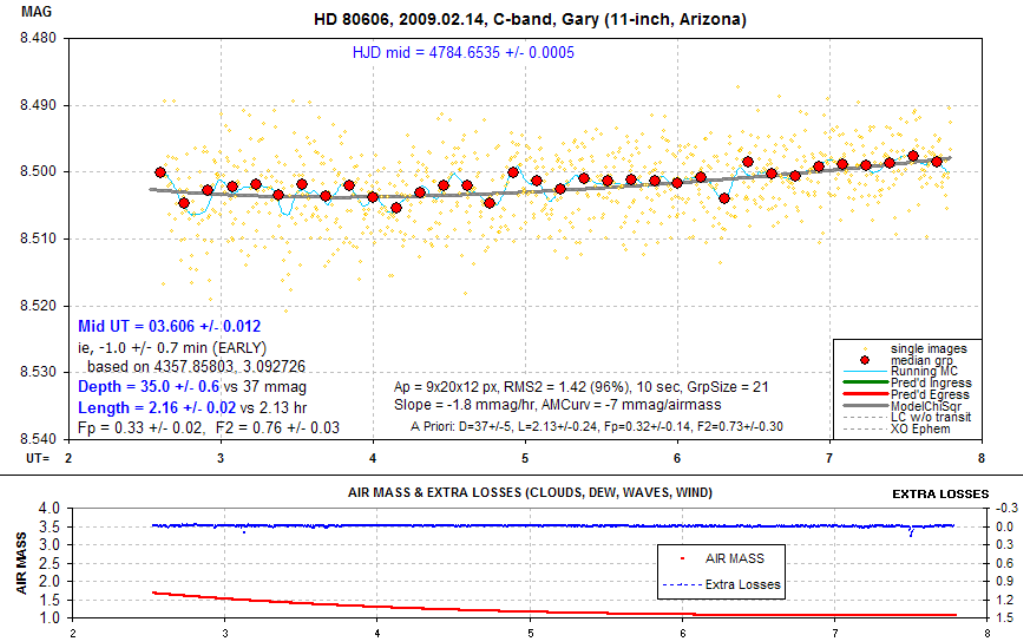
This is the first half of a 13.1-hour observing
session. The rest will be posted later.
HD 17156 for 2007.12.25, 2008.05.11, 2008.10.17
Jose Fernandes (and collaborators) have
suggested (2008 April) that HD 17156 has an additional two exoplanets
besides the well-known 21.2-day planet "b". This speculation is
based on their analysis of radial velocity residuals (using Greg
Laughlin's "Systemic" web site). The most interesting of the suggested
planets is one having a 1.23-day orbital period, planet "d". An ephemeris
for "d" was suggested by Fernandes: HJD
= 2454548.2219 + E * 1.2376222, where
E is an integer. If "d" exists it would probably be in an orbit that
is co-planar with "b" and would therefore transit. Since "d" is is suggested
to have very low mass (2% of Jupiter's mass) any of its transits would
be very small (less than 1 mmag). The Fernandes "systemic" results
can be found at HD17156d
The "observing season" for
HD 17156 is centered on November 9. Transits of "b" (the 21.2-day
planet) are difficult to observe because the transit depth is small
(7 mmag) and the length is long (3.1 hr). Here's one example:
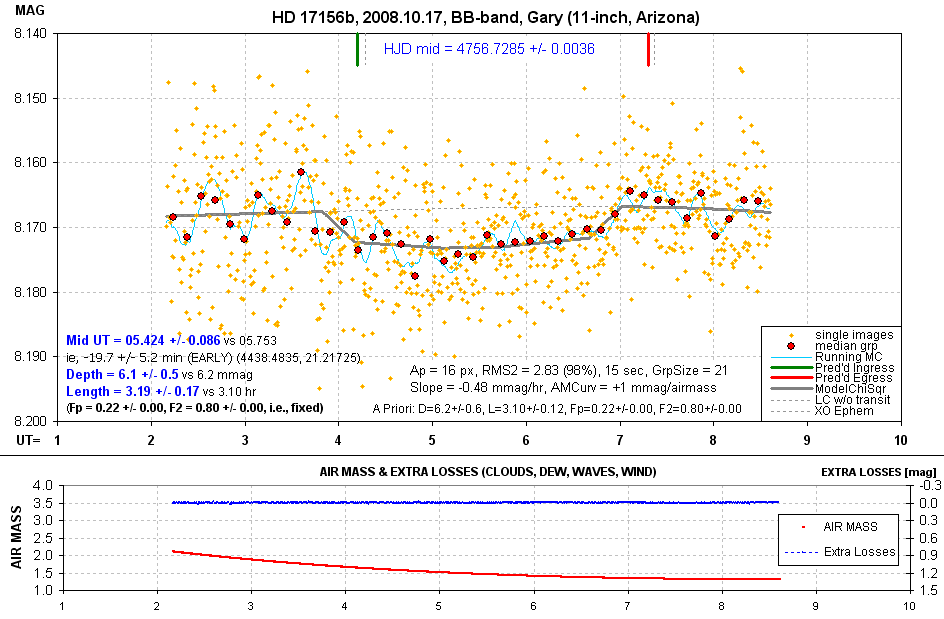
and here's another example:
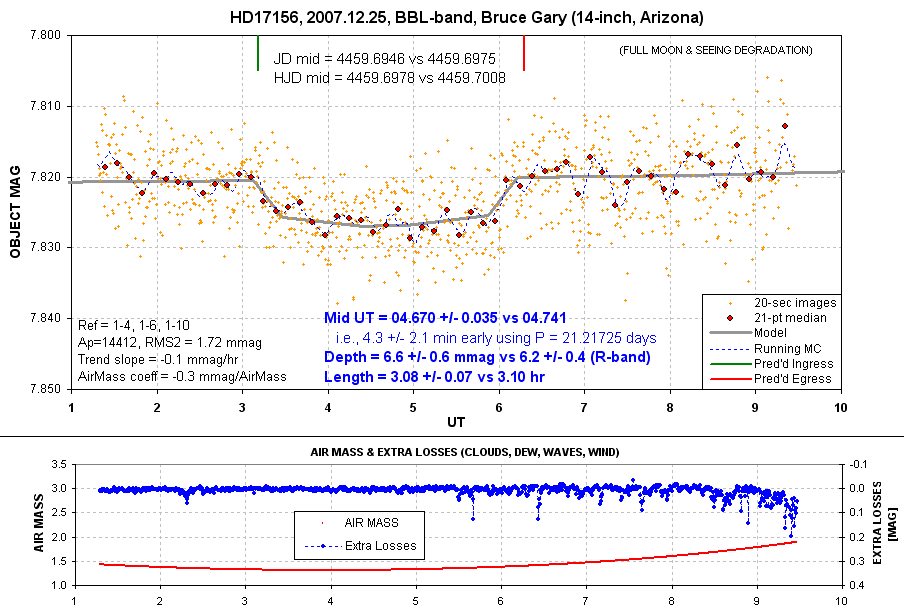
Tonny Vanmunster observed when no transit was predicted
and found this:
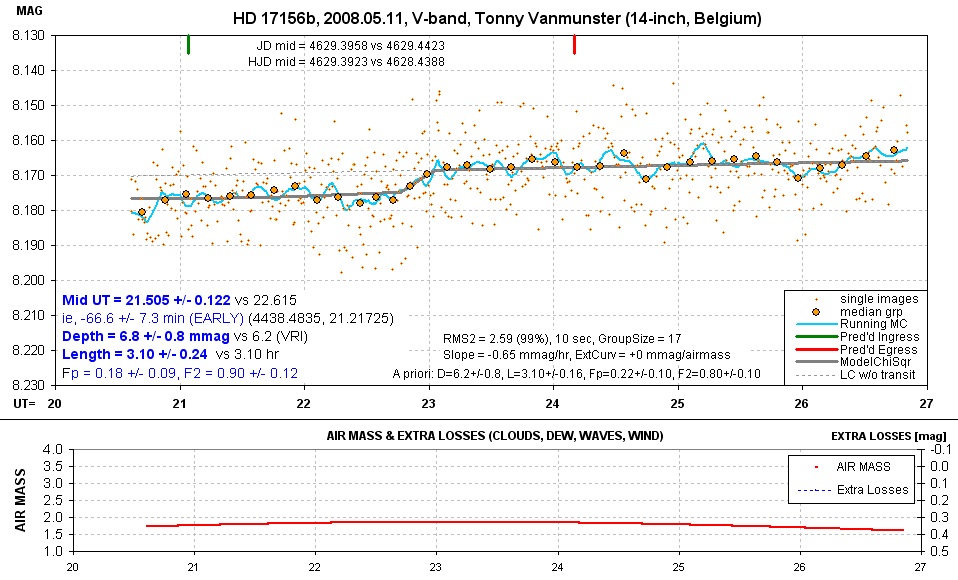
Amazingly, a transit feature is present with the same
depth (and length consistent with the ephemeris-predicted transit
for "b") but at a time when no transit is predicted by the 21.2-day
ephemeris. What's going on? Because of this mystery there is merit
in observing HD 17156 at all times (whenever weather conditions are good).
The next plot is an observation at approximately
the time that "d" is supposed to have transited.
Observation
#6
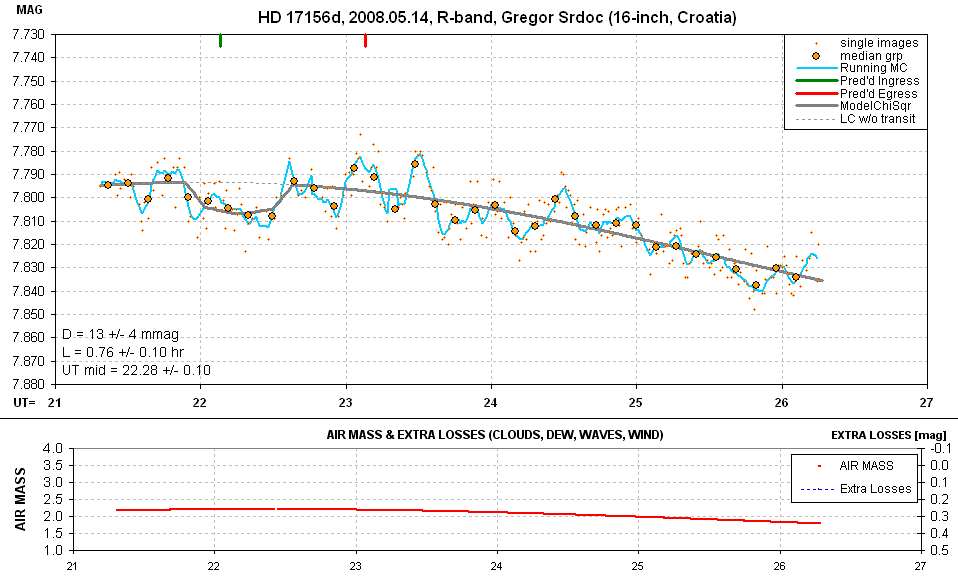
A possible transit for "d" was due at
22.64 UT (based on HJD
= 2454548.2219 + E * 1.2376222). At
22.6 UT a tracking adjustment was made so the possible "dip" at 22.3
UT may not be real.
The following plot is another OOT observation
of HD 17156 when "d" was expected to transit.
Observation #4
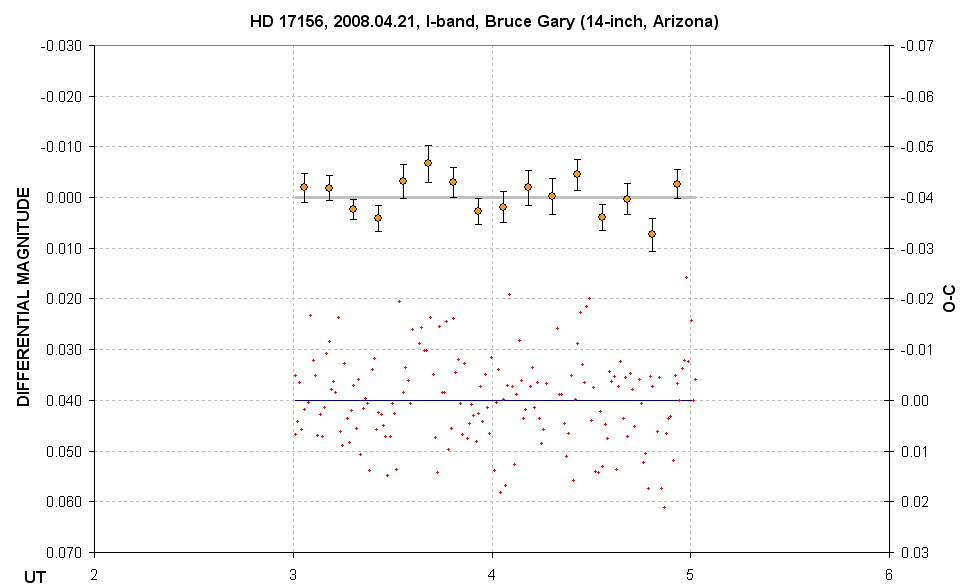

Note that air mass was high the entire
obs'g session. The last 10 minutes were affected by a SRO wall
blocking the aperture. Dynamic aperture was necessary since
seeing varied from 5 to 15 "arc FWHM.
RA/DE = 02:49:44.5,+71:45:12. The observing season
is centered on November 9 (when it crosses meridian at local midnight).
(The ephemeris schedule for possible transits is HJD = 4548.2219
+ E * 1.2376222).
HD 64468
_______________________________________________________________________________________________________
Observation #5
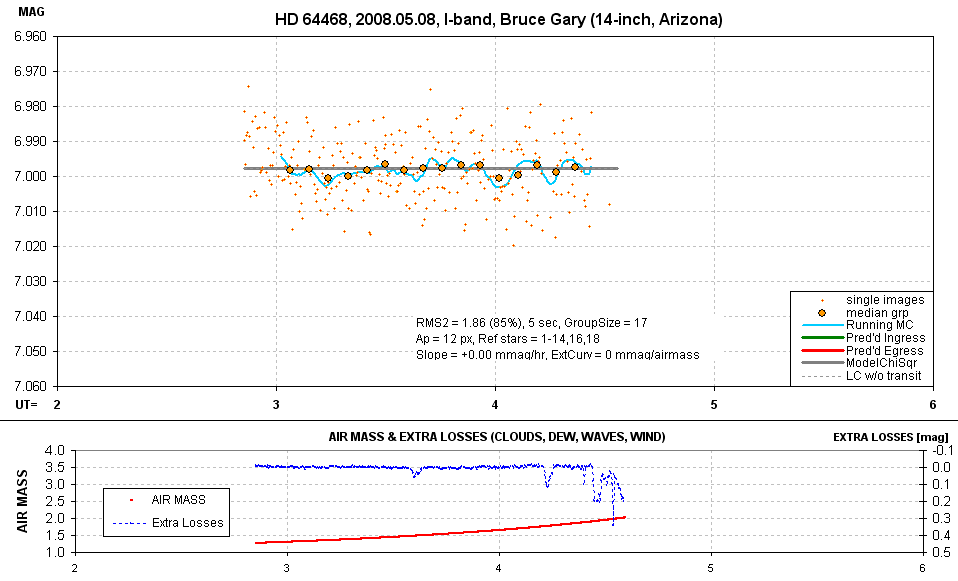
Wind forced an early abort.
HD 46375 _______________________________________________________________________________________________________
Observation #3

This flat LC shows that the transit
feature seen on 2007.12.23 must not have been real, since
that transit predicts a feature in this LC at the times indicated
by the green and red tick marks. The observing conditions were much
better for this LC than the earlier one. The lesson here is that systematic
errors can insinuate themselves into a LC in a most michievous way.
Every new and surprising LC feature must be verified wither by a repeat
observation or a simultansous observation by another observer.
Observation #2

Note: This field is difficult to observe because
of a star 10 "arc to the northwest, 2.7 mag fainter. The presence
of this star renders the LC vulnerable to systematic effects
caused by seeing changes and needed focus changes (unless the
seeing is very good). Therefore, the 11 mmag "transit feature" at
4.4 UT in this LC is questionable. As a check I processed all 1174
images using 4 different aperture sizes; they all show this feature.
Model's transit depth = 11.5 ± 1.5 mmag, length = 2.15 ±
0.20 hr,
mid-transit = 04.43 UT (2007.12.23 UT). The "transit feature" in
this LC is compatible with the predictions (that are based on a
central transit). If the transit feature is real, then comparing
the observed length and depth with the TransitSearch predicted central
transit values allows for the estimate of the impact paramter, b
(central miss distance normalized by the star's radius). My tentative
solution is b = 0.63 ±
0.08,0.10 and Rp/Rs = 0.102 ±
0.005. Since
B-V = 0.85, then Rs = 0.83 * Rsun, which means Rp/Rj = 0.82 ±
0.04 (where Rj = Jupiter's equatorial radius). Here's a LC
plot using the 4 different aperture settings that minimize the
effects of the nearby star.
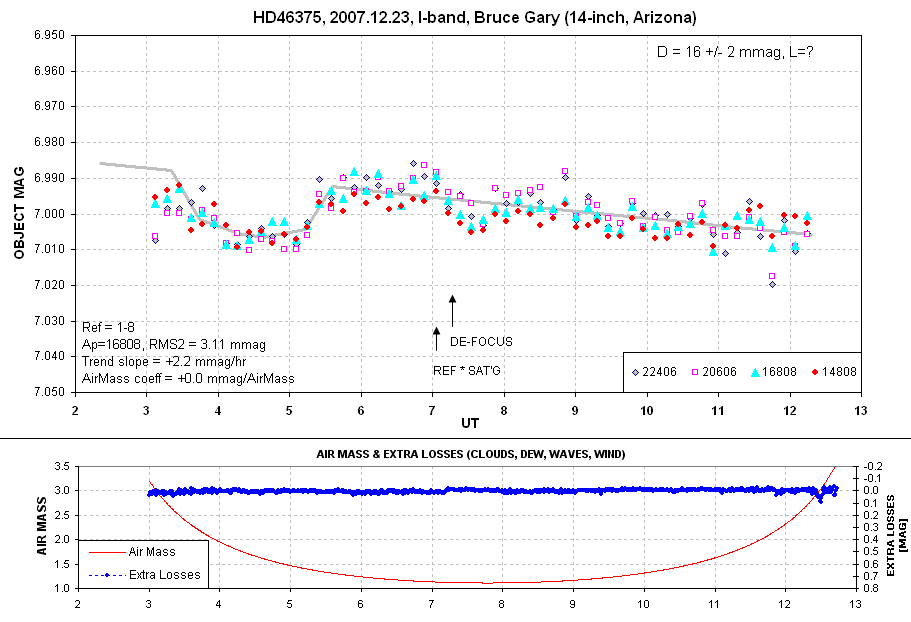
The apparent depth for the average of all aperture
choices is greater than for the small aperture choice used in
the previous LC (the symbol 22406, for example, means the signal aperture
has a radius of 22 pixels, the gap annulus width is 4 pixels and
the sky background annulus is 6 pixels wide). This 16 ±
2 mmag depth
is essentially the same as the maximum calculated by TransitSearch
(15.1 mmag), which could be accounted for with an impact parameter
of zero (central transit). The first few data points are "noisy" due
to their high air mass.
It is worth noting that this exoplanet system
was observed by Henry (2000) and found to lack any evidence for
transits during the interval 1.45 hr before inferior conjunction and
4.35 hr afterwards, as well as a few times scattered throughout the
orbital period (thanks, Joao Gregorio, for calling my attention to
this article). Since the tentative transit feature measured from this
LC occurs near the time with respect to inferior conjunction that is
not covered by Henry's observations it is possible that the two data
sets are compatible. Follow-up observations can use the following ephemeris
(based on this LC's transit feature):
HJD = 2454457.690 + 3.024
* E
At the present time JD = HJD - 7.7 minutes for
this object.
HD 285968 (GJ 176) _______________________________________________________________________________________________________
Observation #1
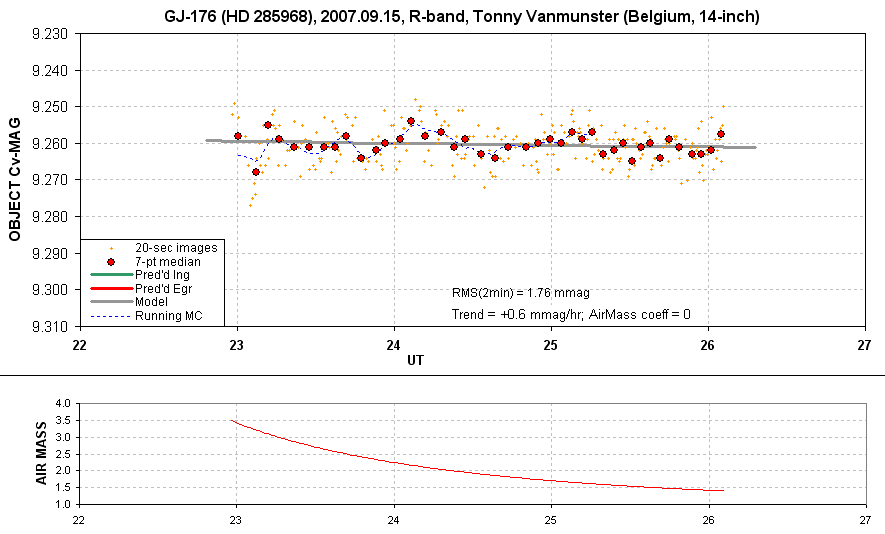
__________________________________________________________________________________________________________________
Return to calling
web page AXA
WebMaster: Bruce L. Gary. Nothing on this web page is copyrighted. This site opened:
December 21, 2007. Last Update: 2009.08.04





















